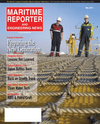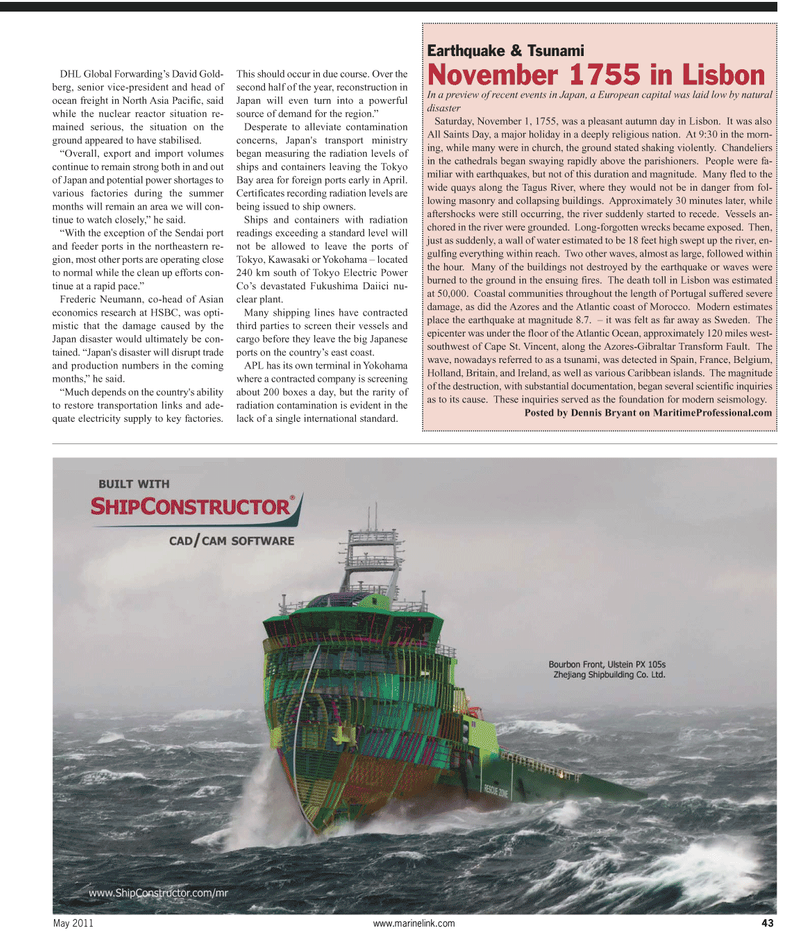
Page 43: of Maritime Reporter Magazine (May 2011)
Training & Education Edition
Read this page in Pdf, Flash or Html5 edition of May 2011 Maritime Reporter Magazine
May 2011 www.marinelink.com 43
DHL Global Forwarding’s David Gold- berg, senior vice-president and head of ocean freight in North Asia Pacific, said while the nuclear reactor situation re- mained serious, the situation on the ground appeared to have stabilised. “Overall, export and import volumes continue to remain strong both in and out of Japan and potential power shortages to various factories during the summer months will remain an area we will con- tinue to watch closely,” he said. “With the exception of the Sendai port and feeder ports in the northeastern re- gion, most other ports are operating close to normal while the clean up efforts con- tinue at a rapid pace.”
Frederic Neumann, co-head of Asian economics research at HSBC, was opti- mistic that the damage caused by the
Japan disaster would ultimately be con- tained. “Japan's disaster will disrupt trade and production numbers in the coming months,” he said. “Much depends on the country's ability to restore transportation links and ade- quate electricity supply to key factories.
This should occur in due course. Over the second half of the year, reconstruction in
Japan will even turn into a powerful source of demand for the region.”
Desperate to alleviate contamination concerns, Japan's transport ministry began measuring the radiation levels of ships and containers leaving the Tokyo
Bay area for foreign ports early in April.
Certificates recording radiation levels are being issued to ship owners.
Ships and containers with radiation readings exceeding a standard level will not be allowed to leave the ports of
Tokyo, Kawasaki or Yokohama – located 240 km south of Tokyo Electric Power
Co’s devastated Fukushima Daiici nu- clear plant.
Many shipping lines have contracted third parties to screen their vessels and cargo before they leave the big Japanese ports on the country’s east coast.
APL has its own terminal in Yokohama where a contracted company is screening about 200 boxes a day, but the rarity of radiation contamination is evident in the lack of a single international standard.
Earthquake & Tsunami
November 1755 in Lisbon
In a preview of recent events in Japan, a European capital was laid low by natural disaster
Saturday, November 1, 1755, was a pleasant autumn day in Lisbon. It was also
All Saints Day, a major holiday in a deeply religious nation. At 9:30 in the morn- ing, while many were in church, the ground stated shaking violently. Chandeliers in the cathedrals began swaying rapidly above the parishioners. People were fa- miliar with earthquakes, but not of this duration and magnitude. Many fled to the wide quays along the Tagus River, where they would not be in danger from fol- lowing masonry and collapsing buildings. Approximately 30 minutes later, while aftershocks were still occurring, the river suddenly started to recede. Vessels an- chored in the river were grounded. Long-forgotten wrecks became exposed. Then, just as suddenly, a wall of water estimated to be 18 feet high swept up the river, en- gulfing everything within reach. Two other waves, almost as large, followed within the hour. Many of the buildings not destroyed by the earthquake or waves were burned to the ground in the ensuing fires. The death toll in Lisbon was estimated at 50,000. Coastal communities throughout the length of Portugal suffered severe damage, as did the Azores and the Atlantic coast of Morocco. Modern estimates place the earthquake at magnitude 8.7. – it was felt as far away as Sweden. The epicenter was under the floor of the Atlantic Ocean, approximately 120 miles west- southwest of Cape St. Vincent, along the Azores-Gibraltar Transform Fault. The wave, nowadays referred to as a tsunami, was detected in Spain, France, Belgium,
Holland, Britain, and Ireland, as well as various Caribbean islands. The magnitude of the destruction, with substantial documentation, began several scientific inquiries as to its cause. These inquiries served as the foundation for modern seismology.
Posted by Dennis Bryant on MaritimeProfessional.com

 42
42

 44
44
